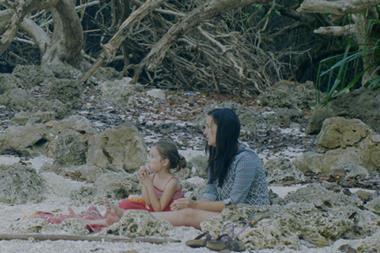When filmmaker Gabrielle Brady went to Christmas Island, a tiny speck of land in the middle of the Indian Ocean, she was expecting to just relax by the beach. Beyond observing the mass migration of forty million red crabs which scuttle from the depths of the jungle toward the coastline every year to spawn, Brady was not anticipating an eventful trip. Amidst the otherworldly beauty of the island, however, she encountered a dark secret in the middle of its dense, luxuriant jungle: A high-security detention centre for hundreds of migrants seeking asylum in Australia. In Island of the Hungry Ghosts, which won Best Documentary at this year’s Tribeca Film Festival, and was screened Nov. 18 by the Montreal International Documentary Festival (RIDM), Brady weaves together multiple narratives of migration into a single hypnotic portrait of ethical and spiritual conflict.
The film follows Poh Lin Lee, a trauma therapist whose job is to support migrants held at the detention centre as they navigate the immigration process. As they recount why they were forced to flee their homeland, detainees disclose how little their lives have improved since reaching Christmas Island. Relating brutal, zoo-like conditions and forced separations from their families, the migrants must wait indefinitely as their fates lie in the hands of bureaucratic immigration officials indifferent to their cries and concerns. The migrants must cope with both the devastation of leaving their old lives behind and the uncertainty of finding a new one in Australia.
For many detainees, the struggle proves unbearable. In one particularly distressing scene, the camera zooms in on Lee’s tear-soaked face as she learns that some of her patients have harmed themselves, including one man who stitched his lips shut to protest his mistreatment in the detention centre. This incident reportedly inspired 20 other inmates to do the same.
Lee offers suggestions to the authorities on how to better accommodate the refugees, but her advice goes unheeded. When her patients fail to show up to appointments, she inquires about the status of their immigration; however, because of confidentiality laws, she does not receive any tangible answers from authorities. Lee’s sense of despair mounts as she tries to help people who are powerless themselves, their spirit breaking down as months turn into years.
According to local legend, the souls of certain people who perished on Christmas Island are caught in limbo. The miners who once worked in the island’s phosphate mines and died without receiving proper burials are among the spirits doomed to wander the jungle for eternity. The island’s inmates, most of whom are of Chinese, Australian, Malay, English and Indian descent, carry out “hungry ghost” rituals to appease the wandering spirits and help them enter the next realm.
By juxtaposing these narratives with the yearly exodus of the red crabs inching their way across the jungle, Island of the Hungry Ghosts poetically exposes the irony and absurdity of current xenophobic attitudes toward migration and refugees. Park rangers and residents go to great lengths to help crustaceans safely make their way to the ocean and carefully assist ‘hungry ghosts’ in their voyages to the beyond, but fail to provide care to the flesh-and-blood human beings in need.
Complemented by an eerie score and a lush, languid cinematography that captures Christmas Island’s beauty, Brady’s film successfully connects viewers with individuals whose humanity has been violated. Prompting timely discussions about immigration and human rights abuses, Island of the Hungry Ghosts’ haunting beauty and troubling relevance linger.








